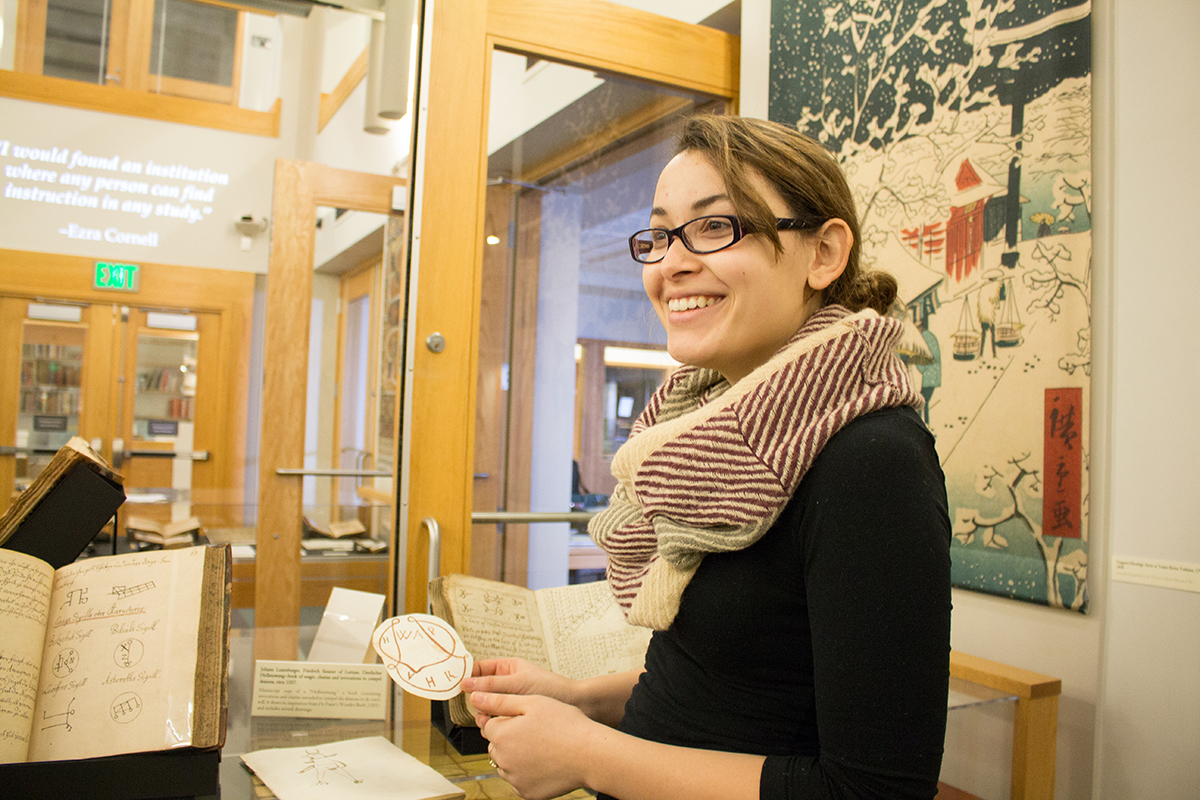Campus collaboration reveals bloody truth of a 16th-century text
By Melanie Lefkowitz

Soon after Fredrika Loew ’12, M.A. ’16, began working at Cornell University Library’s Division of Rare and Manuscript Collections (RMC) a few years ago, she heard the rumor that a 16th-century document, part of RMC’s Witchcraft Collection, was written in blood.
She later included the document – a dark-red drawing of shapes interspersed with letters accompanying a 1557 German book of charms intended to ward off evil spells and demons – in an exhibition she curated, “Gods and Scholars: Studying Religion at a Secular University.” When she mentioned the rumor about the blood to her father, Ellis Loew, professor of physiology and biomedical science at the College of Veterinary Medicine, he suggested he might be able to figure it out.
What followed was an innovative – some might say unusual – marriage of modern technology and ancient lore. It’s also a uniquely Cornell story of bridging disciplinary divides and using nontraditional means to satisfy intellectual curiosity about an item acquired by the personal librarian of Cornell’s co-founder and first president, Andrew Dickson White.
“As a physiologist, I know a lot about blood and the spectral characteristics of blood," said Ellis Loew, who has taught at the Veterinary College since 1975. "The question was, was there a nondestructive way to take advantage of the spectral characteristics of blood to see what we have here?”
Spectral characteristics refer to wavelength and offer a way to classify substances. “I’ve done a lot of work here, at Cornell University Library and other places, looking at the spectral characteristics of paintings and other things. But testing for blood on paper is, for me, a first,” he said.
So one day in January, the elder Loew brought his spectroradiometer, a portable device that can measure and characterize light, to RMC, where his daughter’s exhibition was on display. He pricked his finger for a blood sample for comparison and began setting up.
Fredrika Loew said she’d included the witchcraft document alongside religious texts, such as a first edition of the Book of Mormon, Buddhist palm leaf manuscripts and a King James Bible, because she wanted to feature primary texts.
Although the artifact is intriguing, its use and meaning are far from definitive, said Laurent Ferri, RMC’s curator of pre-1800 collections.
The symbol Ellis Loew tested is likely a sigil, or magical seal used to invoke spirits, Ferri said. The page accompanies a book of Höllenzwang, an occultist tradition initiated by the magician and alchemist Johann Georg Sabellicus Faust, who was born around 1460 in Germany.
The Höllenzwang was acquired in Germany in the late 19th century by George Lincoln Burr, A.D. White’s rare-books librarian, who helped build White’s collections on witchcraft, the Reformation, the French Revolution and many other topics. White’s extensive and eclectic library became the foundation of Cornell University Library and RMC.
Although there is no way of knowing exactly what the sigil represents, in many sigilla or pentacula, an “A” means Amen; “H” stands for “so will ich halten” (“I will keep our pact”); “E” is for “die Erde” (the earth); “C in reverse” stands for Christus or Antichristus; “M” is for Mephisto; and “B” is for Beelzebub, Ferri said in referring to the letters included in the drawing.
“So, this is clearly some sort of magic symbol used for the invocation of ‘spirits,’ or an imitation thereof,” Ferri said. The abundance of fakes and forgeries of similar items discourages him from purchasing this kind of material, Ferri added.
According to legend, Faust confirmed a pact with the devil with a signature written in his own blood.
“And unless you believe in magic, blood when it dries usually turns dark red and then brown,” Ferri said.
After centuries, the ink in Cornell’s sigil remains a rust-colored red.
“There are a lot of things that can look like blood, but only blood has hemoglobin,” Ellis Loew said.
When iron and hemoglobin combine, they create distinctive peaks on his spectroradiometer. But when he tested the sigil, both in the library and later in his lab, he did not see those distinctive peaks. Loew’s research is on the evolution of color vision, and he uses the device to measure the spectral characteristics of light, related to the color vision systems of animals. Because of the degradation of the material, there is a very small chance that the symbol was actually written in blood; however, Ellis Loew concluded, it’s unlikely.
Ferri said one possibility is that the symbol was written with a substance known as “dragons’ blood,” described in Medieval encyclopedias as a pigment formed from the mingling of “the blood of brave elephants and choleric dragons who died in battle.” In actuality, Ferri said, it comes from the sap of the shrub Dracaena cinnabari, a tree native to the Socotra archipelago in the Indian Ocean. The trees’ red sap was often used in alchemy-related books in the 16th century.
Melanie Lefkowitz is a writer and editor at Cornell University Library.
Media Contact
Get Cornell news delivered right to your inbox.
Subscribe